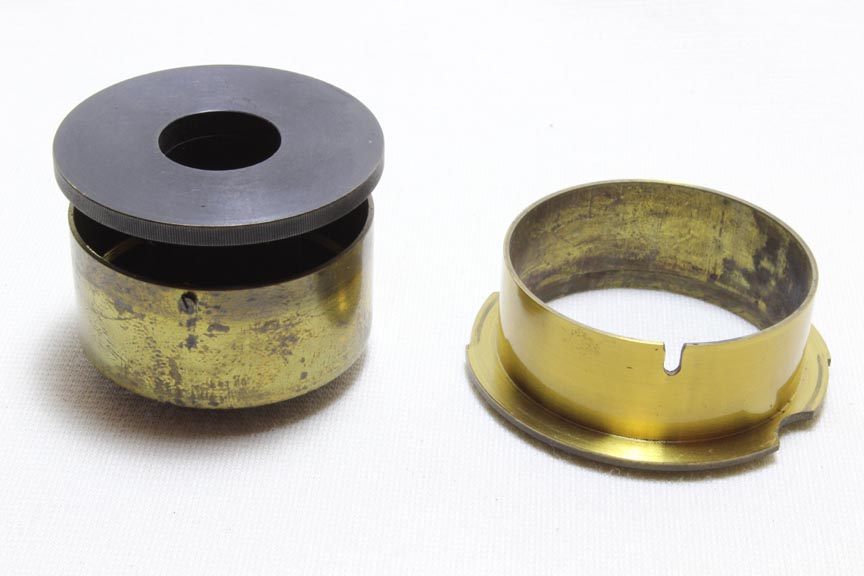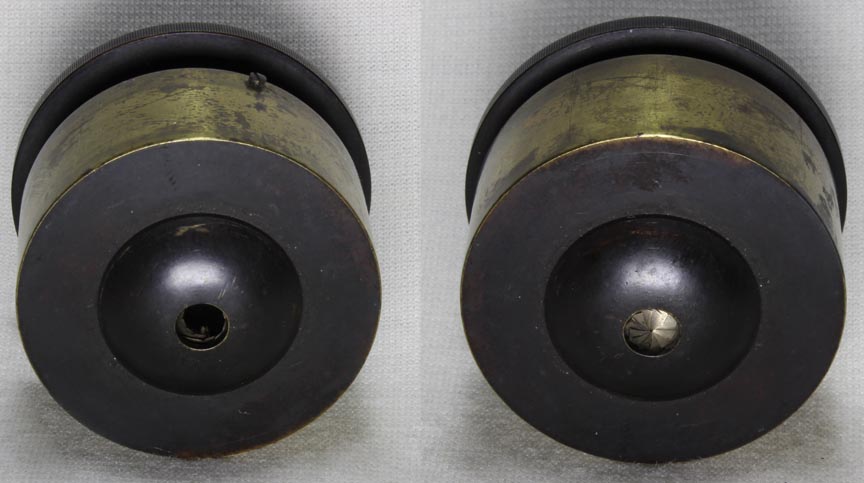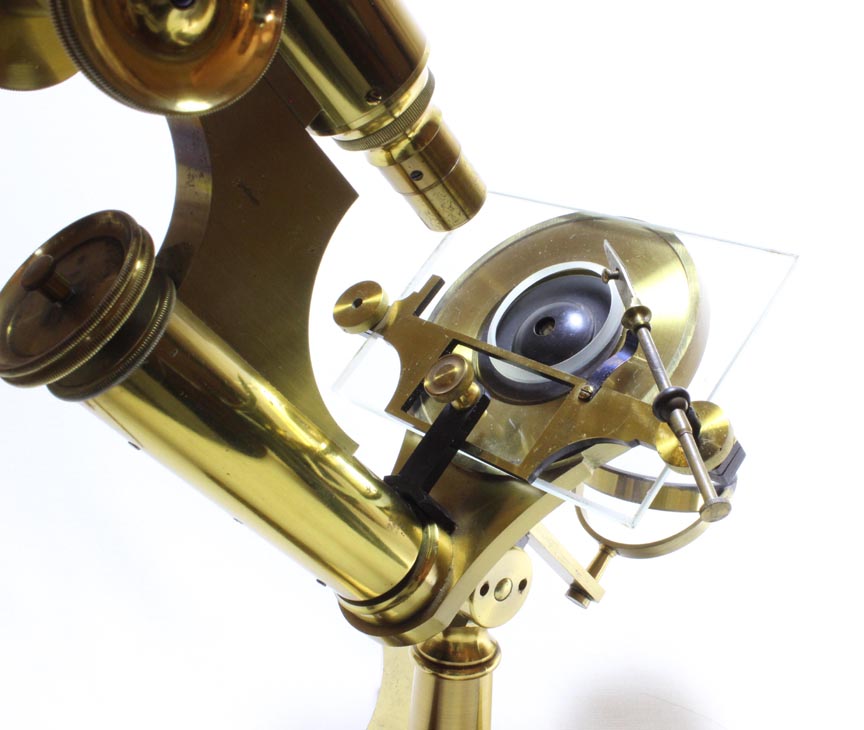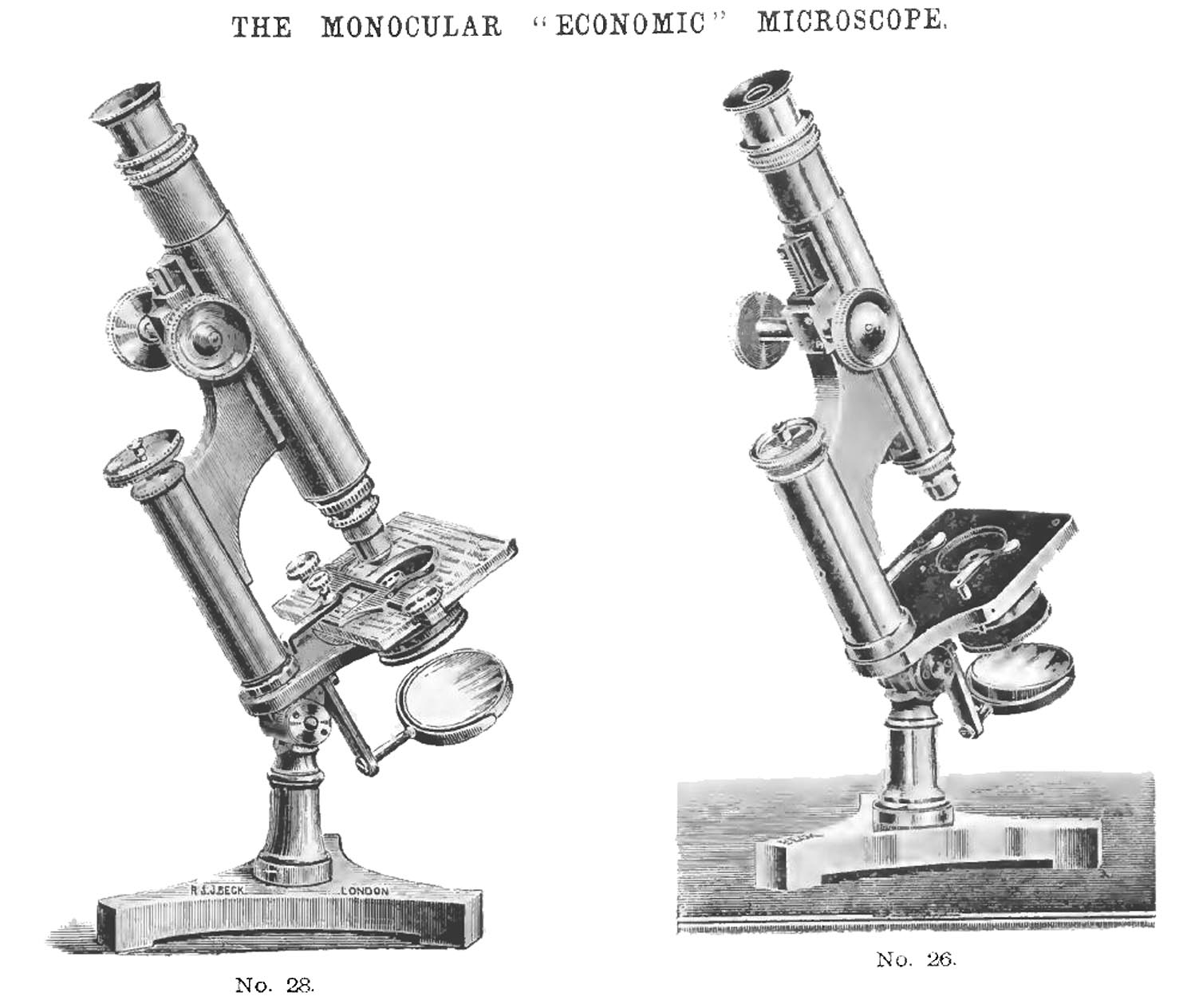MICROSCOPE-ANTIQUES.COM © 2013-15.
R. & J. BECK MICROSCOPE
YEAR: c. 1886
SIGNED: R. & J. BECK, LONDON & PHILADELPHIA
and also WALMSLEY & Co, PHILADELPHIA, SOLE AMERICAN AGENTS
SERIAL NUMBER: 15430
MODEL: ECONOMIC
DESCRIPTION:

 This microscope has two signatures, each on a different projection of the foot. These signatures are as noted above.
This microscope arises from an equiaxed flat tripod, much like the American style foot. It has an inclination joint at the top of a short pillar. The plano and concave mirror is on a single swinging arm, attached to the tailpiece allowing oblique illumination which is facilitated by removal of the substage bayonet-fitted condenser sleeve. In this version of the stand, the entire substage ring fitting can be removed to allow for extremely oblique lighting; a later version has cutouts on each side of the ring to obviate the need to remove the ring completely. Removing the ring is easy as it is fixed by a simple bayonet arrangement. With this example is a Wale type of variable diaphragm. The range of the opening is surprising. Many of these microscopes came with a bullseye condenser which attached to the stage, but this is lacking in this example. Coarse focus is by straight rack and pinion, fine by micrometer screw acting on the stem. There is a drawtube which extends to allow optimal use of the objectives and two objectives and two oculars are present. Additional accessories include a brass tweezers and both straight and angled wooden-handled disecting needles. The original hardwood case is in good condition with working lock and key.
This microscope has two signatures, each on a different projection of the foot. These signatures are as noted above.
This microscope arises from an equiaxed flat tripod, much like the American style foot. It has an inclination joint at the top of a short pillar. The plano and concave mirror is on a single swinging arm, attached to the tailpiece allowing oblique illumination which is facilitated by removal of the substage bayonet-fitted condenser sleeve. In this version of the stand, the entire substage ring fitting can be removed to allow for extremely oblique lighting; a later version has cutouts on each side of the ring to obviate the need to remove the ring completely. Removing the ring is easy as it is fixed by a simple bayonet arrangement. With this example is a Wale type of variable diaphragm. The range of the opening is surprising. Many of these microscopes came with a bullseye condenser which attached to the stage, but this is lacking in this example. Coarse focus is by straight rack and pinion, fine by micrometer screw acting on the stem. There is a drawtube which extends to allow optimal use of the objectives and two objectives and two oculars are present. Additional accessories include a brass tweezers and both straight and angled wooden-handled disecting needles. The original hardwood case is in good condition with working lock and key.
CONDITION:
 The microscope is in superb condition with minimal slight losses to the lacquer. All controls and joints work properly. The Wale diaphragm works amazingly well. The objectives have dust caps which fit on top of each. There is an original brass handle for the dovetailed case. The case is in excellent condition except for the usual cracks in the solid wooden back. There are multiple tiny areas of spotting of the concave but not the flat mirror.
The microscope is in superb condition with minimal slight losses to the lacquer. All controls and joints work properly. The Wale diaphragm works amazingly well. The objectives have dust caps which fit on top of each. There is an original brass handle for the dovetailed case. The case is in excellent condition except for the usual cracks in the solid wooden back. There are multiple tiny areas of spotting of the concave but not the flat mirror.
HISTORY OF THE BECK ECONOMIC MODEL
 The 'Economic' model was first brought out in the late 1870's and made through at least 1894. This outfit, as equipped, sold for £8 in 1894, about £822 or $1072 today. Various upgrades were available. This is number '28A' as described in the 1894 catalog, as it includes two objectives, two eyepieces, the sliding glass stage, the Wale diaphragm and the mahogany case, all extras. For a cheaper version with a simpler stage and also simpler substage aperture and plain stage, see my page about another Example of a Beck Economic. A similar, but somewhat less common model, with the addition of a sector substage was called the 'Ideal' model and was first announced in 1881 in the JRMS. All the 'Economic' and 'Ideal' models could be supplied with the equiaxed foot seen here, or the horseshoe style foot popularized on the continent. They could also be supplied with all lacquered brass finish, or with oxidized brass finish to the housing for the optical tube and limb (at lower cost). Various options were available for it both above and below the stage. This example features a Zentmayer-type Glide stage and also a Wale diaphragm.
The 'Economic' model was first brought out in the late 1870's and made through at least 1894. This outfit, as equipped, sold for £8 in 1894, about £822 or $1072 today. Various upgrades were available. This is number '28A' as described in the 1894 catalog, as it includes two objectives, two eyepieces, the sliding glass stage, the Wale diaphragm and the mahogany case, all extras. For a cheaper version with a simpler stage and also simpler substage aperture and plain stage, see my page about another Example of a Beck Economic. A similar, but somewhat less common model, with the addition of a sector substage was called the 'Ideal' model and was first announced in 1881 in the JRMS. All the 'Economic' and 'Ideal' models could be supplied with the equiaxed foot seen here, or the horseshoe style foot popularized on the continent. They could also be supplied with all lacquered brass finish, or with oxidized brass finish to the housing for the optical tube and limb (at lower cost). Various options were available for it both above and below the stage. This example features a Zentmayer-type Glide stage and also a Wale diaphragm.
The Wale diaphragm is a variable substage opening which was much less expensive to make than an iris diaphragm. The original Wale diaphragm was patented in the U.S.A. by George Wale in June of 1876, and reported in the JRMS in 1880. Wale's version differs mainly in that the opening is varied by screwing it in and out via a thread, whereas the Beck example here screws in and out via a spiral slot. Nevertheless, Beck's example works very well.
The glide stage is a variation on Zentmayer's original which was made mainly of brass. The Beck stage consists of a large glass plate with a large central opening. Attached to the plate is a removable brass slide holder with knobs which both serve as handles, and which have holes to accept accessories like a stage forceps. The glass rides on the raised edges of the circular brass stage. This stage was also offered as an option on the more expensive Beck 'Ideal' model. It differs from the original form of Zentmayer in that it is mainly made of glass, the glass providing the contact surface with the stage. In Zentmayer's original version, most of this device was made of brass with glass only in a window which was the contact point for the adjustable-tension screw. In addition, Zentmayer's slid on two raised bars of brass, whereas Beck's contact area was the raised edge of the entire circular stage.
In the U.S.A. the Beck Economic was initially sold by Queen and Co in the 1870's, it was then sold 'exclusively' by W.H. Walmsley & Co. Walmsley, had worked for Queen, but left, (apparently along with the contract to sell Beck microscopes) in about 1877. Walmsley was apparently not the sole agent initially, but soon his catalogs stated he was the sole agent for Beck in the U.S.A. This model was featured prominently in the Walmsley catalogs from the late 1870's and early 1880's. Walmsley sold the simpler version, without rack and pinion coarse focusing for about $30 and the one with the rack and pinion for about $50-that is close to the price for the microscope if bought in England. The microscope was advertised as a 'Medical Student's' microscope. It was quite similar in size, features, and cost to Walter Bulloch's 'New Student' microscope of about 1885, although in the author's opinion, Bulloch's stand was made to a higher standard, and had a swinging tailpiece which rotated through an axis which was at the level of the specimen rather than the type Beck provided in the 'Economic' which depended on a single-jointed arm which originated from a fixed tailpiece below the stage. Nevertheless, a good degree of oblique lighting can be provided by the substage mirror in this Economic model by removing the condenser sleeve which is easy to do since it is a simple bayonet fitting. As mentioned above, Beck later modified the sleeve with cutouts on its sides to permit some oblique lighting without removing the sleeve. Although Walmsley sold some very simple models by other makers, none of these was similar to the microscopes of Beck that he sold. This is in contrast to both Queen and McAllister. Queen supplied the Acme models made by Sidle, and McAllister supplied his own microscopes while at the same time selling Beck Microscopes.

 This microscope has two signatures, each on a different projection of the foot. These signatures are as noted above.
This microscope arises from an equiaxed flat tripod, much like the American style foot. It has an inclination joint at the top of a short pillar. The plano and concave mirror is on a single swinging arm, attached to the tailpiece allowing oblique illumination which is facilitated by removal of the substage bayonet-fitted condenser sleeve. In this version of the stand, the entire substage ring fitting can be removed to allow for extremely oblique lighting; a later version has cutouts on each side of the ring to obviate the need to remove the ring completely. Removing the ring is easy as it is fixed by a simple bayonet arrangement. With this example is a Wale type of variable diaphragm. The range of the opening is surprising. Many of these microscopes came with a bullseye condenser which attached to the stage, but this is lacking in this example. Coarse focus is by straight rack and pinion, fine by micrometer screw acting on the stem. There is a drawtube which extends to allow optimal use of the objectives and two objectives and two oculars are present. Additional accessories include a brass tweezers and both straight and angled wooden-handled disecting needles. The original hardwood case is in good condition with working lock and key.
This microscope has two signatures, each on a different projection of the foot. These signatures are as noted above.
This microscope arises from an equiaxed flat tripod, much like the American style foot. It has an inclination joint at the top of a short pillar. The plano and concave mirror is on a single swinging arm, attached to the tailpiece allowing oblique illumination which is facilitated by removal of the substage bayonet-fitted condenser sleeve. In this version of the stand, the entire substage ring fitting can be removed to allow for extremely oblique lighting; a later version has cutouts on each side of the ring to obviate the need to remove the ring completely. Removing the ring is easy as it is fixed by a simple bayonet arrangement. With this example is a Wale type of variable diaphragm. The range of the opening is surprising. Many of these microscopes came with a bullseye condenser which attached to the stage, but this is lacking in this example. Coarse focus is by straight rack and pinion, fine by micrometer screw acting on the stem. There is a drawtube which extends to allow optimal use of the objectives and two objectives and two oculars are present. Additional accessories include a brass tweezers and both straight and angled wooden-handled disecting needles. The original hardwood case is in good condition with working lock and key.
 The microscope is in superb condition with minimal slight losses to the lacquer. All controls and joints work properly. The Wale diaphragm works amazingly well. The objectives have dust caps which fit on top of each. There is an original brass handle for the dovetailed case. The case is in excellent condition except for the usual cracks in the solid wooden back. There are multiple tiny areas of spotting of the concave but not the flat mirror.
The microscope is in superb condition with minimal slight losses to the lacquer. All controls and joints work properly. The Wale diaphragm works amazingly well. The objectives have dust caps which fit on top of each. There is an original brass handle for the dovetailed case. The case is in excellent condition except for the usual cracks in the solid wooden back. There are multiple tiny areas of spotting of the concave but not the flat mirror.
 The 'Economic' model was first brought out in the late 1870's and made through at least 1894. This outfit, as equipped, sold for £8 in 1894, about £822 or $1072 today. Various upgrades were available. This is number '28A' as described in the 1894 catalog, as it includes two objectives, two eyepieces, the sliding glass stage, the Wale diaphragm and the mahogany case, all extras. For a cheaper version with a simpler stage and also simpler substage aperture and plain stage, see my page about another Example of a Beck Economic. A similar, but somewhat less common model, with the addition of a sector substage was called the 'Ideal' model and was first announced in 1881 in the JRMS. All the 'Economic' and 'Ideal' models could be supplied with the equiaxed foot seen here, or the horseshoe style foot popularized on the continent. They could also be supplied with all lacquered brass finish, or with oxidized brass finish to the housing for the optical tube and limb (at lower cost). Various options were available for it both above and below the stage. This example features a Zentmayer-type Glide stage and also a Wale diaphragm.
The 'Economic' model was first brought out in the late 1870's and made through at least 1894. This outfit, as equipped, sold for £8 in 1894, about £822 or $1072 today. Various upgrades were available. This is number '28A' as described in the 1894 catalog, as it includes two objectives, two eyepieces, the sliding glass stage, the Wale diaphragm and the mahogany case, all extras. For a cheaper version with a simpler stage and also simpler substage aperture and plain stage, see my page about another Example of a Beck Economic. A similar, but somewhat less common model, with the addition of a sector substage was called the 'Ideal' model and was first announced in 1881 in the JRMS. All the 'Economic' and 'Ideal' models could be supplied with the equiaxed foot seen here, or the horseshoe style foot popularized on the continent. They could also be supplied with all lacquered brass finish, or with oxidized brass finish to the housing for the optical tube and limb (at lower cost). Various options were available for it both above and below the stage. This example features a Zentmayer-type Glide stage and also a Wale diaphragm.